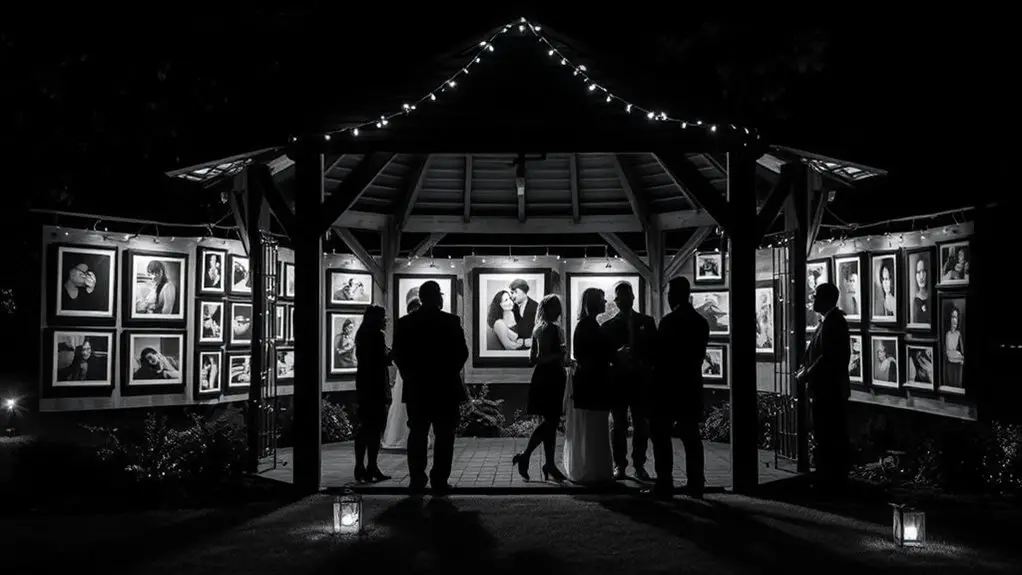Hosting a black-and-white photography exhibition in your gazebo allows you to create a unique, intimate space for artistic expression. Start by selecting a compelling theme that resonates with your visual narrative. Prepare your gazebo with warm lighting and a clean layout to enhance the ambiance. Use strategic display techniques to showcase your images, drawing attention to their intricate details. As you invite guests, consider adding music and refreshments, enhancing the overall experience. Explore further ideas to elevate your exhibition.
Choosing the Right Theme and Images
How do you decide on the perfect theme for your black-and-white photography exhibition? Start by exploring your creative passions—what stories do you want to tell? Theme selection is essential; it sets the emotional tone and unifies your work. Consider concepts like solitude, nature, or urban decay. Each theme opens a distinct pathway for image curation, guiding your choices and ensuring coherence. As you sift through your portfolio, think about how each piece resonates with the theme. Are the emotions raw and relatable? Do the images evoke a sense of freedom or introspection? Ultimately, the combination of a compelling theme and carefully curated images will not only showcase your vision but also invite your audience to begin a journey of discovery.
Preparing Your Gazebo for the Exhibition
Once you’ve selected an enchanting theme and curated your images, the next step is preparing your gazebo for the exhibition. Effective gazebo maintenance is essential; a clean, inviting space will enhance your viewers’ experience. Consider how lighting options can transform the ambiance, highlighting the depth and contrast of your black-and-white photographs.
Preparing your gazebo with effective maintenance and thoughtful lighting enhances the exhibition experience for your viewers.
- Soft overhead lights creating a warm glow
- Strategic spotlights illuminating focal pieces
- Natural light filtering through the gazebo’s structure
Incorporating energy-efficient designs will not only enhance the visual appeal but also reduce electricity costs during your exhibition.
Display Techniques for Monochrome Photography
While curating your black-and-white photography exhibition, the way you display your images can profoundly influence the viewer’s perception and emotional response. Employing contrast techniques is key; consider placing lighter images against darker backgrounds to create striking visual tension. This not only highlights the intricate details but also draws the eye, inviting viewers to explore deeper meanings.
Framing suggestions can further enhance your display; opt for sleek, minimalist frames that complement the monochrome aesthetic without overwhelming the artwork. Experiment with varying frame sizes and orientations to create a dynamic flow throughout your gazebo. By carefully considering these display techniques, you’ll empower your audience to experience the raw beauty and emotion captured in your photographs, allowing their imaginations to roam freely.
Inviting Guests and Promoting Your Event
To guarantee your black-and-white photography exhibition draws a diverse audience, consider crafting an inviting narrative that resonates with potential guests. Share your vision through various channels, focusing on a compelling guest list that embodies artistic freedom. Utilize social media platforms to amplify your message, showcasing the unique allure of monochrome art.
- A serene gazebo bathed in soft, natural light
- Striking contrasts that evoke emotion and provoke thought
- Guests mingling, exchanging stories, and experiencing art together
Additionally, hosting your exhibition in a gazebo can enhance outdoor comfort and create a shaded area that promotes a relaxed atmosphere for attendees to enjoy the art.
Enhancing the Experience With Music and Refreshments
As your guests immerse themselves in the enchanting world of black-and-white photography, the right selection of music and refreshments can elevate the overall experience, creating an atmosphere that encourages connection and contemplation. Choose a music selection that resonates with the theme—soft jazz or ambient tunes can evoke emotions that complement the visual artistry. Consider live performers if space allows; their presence adds a personal touch.
For refreshment options, offer an elegant array of finger foods, perhaps a charcuterie board paired with artisanal cheeses, alongside invigorating beverages like infused water or a selection of wines. These thoughtful choices not only satisfy the senses but also invite conversation, allowing your guests to savor both the art and the moment in a harmonious setting.
Frequently Asked Questions
Do I Need a Permit to Host an Exhibition in My Backyard?
You might think you can skip the red tape, but local permits often govern exhibition regulations. It’s wise to check with your municipality to guarantee your backyard showcase aligns with local laws and avoids potential fines.
How Can I Protect My Photographs From Weather Elements?
To protect your photographs from weather elements, consider using weatherproof displays and protective coverings. These solutions not only safeguard your art but also enhance its visual impact, allowing viewers to appreciate your work, rain or shine.
What Types of Lighting Work Best for Black-And-White Photography?
For striking black-and-white photography, natural light’s soft shadows and contrasts are ideal, while artificial lighting can add dramatic effects. Experimenting with both will help you capture emotion and depth, allowing your vision to truly shine.
Can I Display Digital Images Instead of Prints?
Did you know that 70% of viewers prefer digital displays for exhibitions? You can absolutely use digital display options or virtual exhibition platforms to showcase your work, expanding accessibility while embracing modern technology and artistic freedom.
How Do I Handle Sales During the Exhibition?
To handle sales during the exhibition, consider various pricing strategies and offer multiple payment methods. This flexibility not only enhances the buying experience but also empowers visitors to engage freely with your art.

